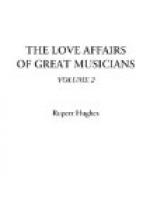The comtesse died of pleurisy in 1876, at the age of seventy-one. How long these sweethearts of musicians last!
Thus closes the chapter of Liszt’s affairs with the Comtesse d’Agoult. It had lasted, all things considered, surprisingly long—five years.
A pleasant note of character was sounded by Liszt, which rings him to the difficult love affair of Robert Schumann. In one of his letters, Liszt tells how fond he had been of Schumann and Wieck and his daughter Clara. Then came the famous struggle between father and suitor for the possession of the girl. Liszt took Schumann’s side, because he thought he was in the right; he even went so far as to break off all intercourse with Wieck—who took his revenge by publishing ferocious criticisms on Liszt’s playing.
In 1845 Liszt wrote a letter of calm, cool friendship to George Sand, his “Dear George.” For years he roved Europe, flitting from ovation to ovation, from flirtation to flirtation. But he was drifting unwittingly toward the grand affair of his life. A woman—the woman—was waiting for him in Russia. Mr. Huneker says of Liszt and the Comtesse d’Agoult: “Every one knows that he was as so much dough in her hands.” So, in a more than different way, we shall find him—who had slain his hecatomb of hearts—helpless in the power of his one great love. Again he is first compelling, then compelled.
February 8, 1819, in Monasterzyka in Kiev, Carolyne von Ivanovska was born. She was the only daughter of a rich Polish nobleman. The parents soon separated, and the child’s life was divided between them. The father brought her up, as La Mara tells, as if she were a boy. He made her the companion of his conversations late into the night; and, in order to make her the more congenial a comrade, he taught her to ride wild horses and smoke strong cigars. Then the other half of the year, she was the ward of her “beautiful, lovely, elegant” mother, who doted on society, and introduced her daughter to the capitals and the salons of Europe.
So, says La Mara, “under constantly changing surroundings, now in the midst of the world, now in the deep solitude, Carolyne von Ivanovska lived her first years.”
When she was seventeen, her father bought her a husband, the son of the Field Marshal Fuerst Wittgenstein, and on May 7, 1836, she gave her hand to the Prince Nicolaus von Sayn-Wittgenstein, seven years her senior. He was at the time a cavalry captain in the Russian army, a handsome, but intellectually unimpressive man. To quote La Mara again: “From this marriage the Princess Carolyne gained only one happiness: the birth of a daughter, the Princess Marie, on whom she centred the glowing love of her heart.”
While the two fathers-in-law lived, the children-in-law were kept together; but the old men soon went their way. Then the young wife gave up attempting to endure the unhappiness of her home, and sought solace from her loneliness in the full blaze of literary and artistic society. In February, 1847, Franz Liszt floated in across her horizon, “auf Fluegeln des Gesanges.” Of course, he gave a concert in Kiev for charity. Among the contributions, he received a one-hundred-rouble note—about $75. Liszt desired to thank the good-hearted one in person—Kismet!




